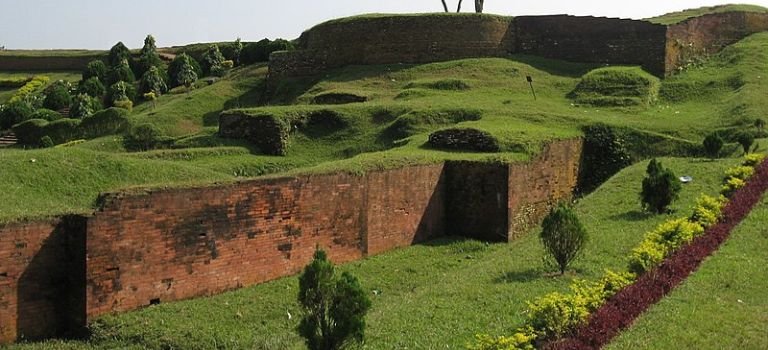A Tale of Two Cities: Unveiling the Ancient Wonders of Mahasthangarh and Paharpur
Bangladesh, a land brimming with vibrant culture and breathtaking natural beauty, also boasts a rich tapestry of history. Standing as testaments to this bygone era are Mahasthangarh and Paharpur, two archaeological marvels that whisper tales of ancient civilizations and flourishing empires. Let’s embark on a journey through time, exploring the unique character and significance of each of these captivating sites.
Mahasthangarh: Unveiling the “Great Place of Learning”
Nestled amidst the verdant plains of northern Bangladesh lies Mahasthangarh, aptly translated as the “Great Place of Learning.” This sprawling archaeological complex, dating back to at least the 3rd century BC, is acknowledged as the earliest urban settlement discovered in the country. Once known as Pundranagara or Paundravardhanapura, Mahasthangarh served as the capital of the powerful Pundravardhana kingdom, a prominent entity during the Mauryan Empire.

A City Fortified: Exploring the Citadel Walls
Dominating the landscape of Mahasthangarh are the imposing fortified walls, constructed from earth and brick. These formidable structures served as a vital defensive measure, protecting the city from invaders. The strategic location of the city on the banks of the Korotoa River further bolstered its security. Walking along these ancient ramparts, one can’t help but imagine the bustling life that once unfolded within these very walls. Excavations have revealed the presence of various structures, including residential areas, administrative buildings, and religious complexes, offering a glimpse into the city’s well-organized layout.
A Tapestry of Faiths: Unveiling Buddhist Vihars and Hindu Temples
Mahasthangarh reflects the diverse religious landscape of ancient Bengal. Excavations have unearthed the remains of several Buddhist viharas, monasteries dedicated to spiritual learning and practice. One such example is the aptly named “Bihara Complex,” showcasing the well-preserved remains of monastic cells and courtyards. These structures, often adorned with intricate carvings depicting scenes from Buddhist mythology, offer a glimpse into the flourishing Buddhist culture that once dominated the region.
Beyond the Buddhist influence, Mahasthangarh also reveals evidence of Hinduism’s presence. The imposing structure of the Govinda Bhita temple complex, dating back to the 6th-7th centuries AD, stands as a testament to this. This pyramid-shaped temple, constructed from red bricks, offers an intriguing glimpse into the architectural styles prevalent during this period.
Artifacts Unearthed: Whispers from the Past
The Mahasthangarh Archaeological Museum serves as a treasure trove of artifacts unearthed from the site. From intricately carved terracotta plaques depicting scenes from mythology to finely crafted bronze sculptures and ancient coins, these objects offer a tangible connection to the lives of those who once inhabited this city. A particularly noteworthy discovery is the “Mahasthangarh Pillar,” a massive stone column bearing inscriptions that provide valuable insights into the socio-political landscape of the era.
Beyond the Ruins: Legends and Local Lore
Mahasthangarh is not merely a collection of archaeological remains; it is a place steeped in captivating legends and local lore. One such story revolves around the enigmatic figure of Shah Sultan Mahisawar, a revered Sufi saint believed to have resided in the city. His mausoleum, located within the citadel walls, draws pilgrims from far and wide. Another fascinating tale is associated with the “Jiyat Kunda,” an ancient well believed to possess mystical healing powers.
A Beacon of Cultural Heritage: Preserving the Legacy
The Bangladesh government, recognizing the immense historical significance of Mahasthangarh, has undertaken extensive efforts to preserve this archaeological marvel. Ongoing excavation and restoration projects ensure that future generations can continue to learn from the whispers of the past. The Mahasthangarh Archaeological Museum plays a crucial role in educating visitors about the site’s rich history and displaying the unearthed artifacts.
Paharpur: A Legacy of Buddhist Grandeur
Travel further south to Naogaon District, where the majestic ruins of Somapura Mahavihara, also known as Paharpur, stand as a testament to the flourishing Buddhist tradition in ancient Bengal. This UNESCO World Heritage Site, built in the 8th century AD during the reign of the Pala dynasty, was once the largest Buddhist monastery south of the Himalayas.
A Monastic Marvel: Exploring the Somapura Mahavihara Complex
The architectural grandeur of Paharpur is truly awe-inspiring. The sprawling complex, constructed from fired bricks, features a central Vihara, surrounded by numerous monastic cells arranged in a grid-like pattern. The central Vihara, adorned with intricate terracotta plaques depicting various Buddhist deities and scenes from the Jataka tales, served as a place of worship and meditation for the resident monks. The well-preserved monastic cells, with their verandahs

